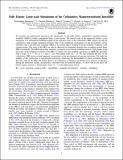| dc.contributor.author | Inchingolo, Giannandrea | |
| dc.contributor.author | Grismayer, Thomas | |
| dc.contributor.author | Gomes Loureiro, Nuno F | |
| dc.contributor.author | Fonseca, Ricardo A. | |
| dc.contributor.author | Silva, Luis O. | |
| dc.date.accessioned | 2021-09-09T14:03:49Z | |
| dc.date.available | 2020-03-24T19:24:12Z | |
| dc.date.available | 2021-09-09T14:03:49Z | |
| dc.date.issued | 2018-06 | |
| dc.date.submitted | 2018-04 | |
| dc.identifier.issn | 1538-4357 | |
| dc.identifier.uri | https://hdl.handle.net/1721.1/124294.2 | |
| dc.description.abstract | We present two-dimensional particle-in-cell simulations of the fully kinetic collisionless magnetorotational instability (MRI) in weakly magnetized (high β) pair plasma. The central result of this numerical analysis is the emergence of a self-induced turbulent regime in the saturation state of the collisionless MRI, which can only be captured for large enough simulation domains. One of the underlying mechanisms for the development of this turbulent state is the drift-kink instability (DKI) of the current sheets resulting from the nonlinear evolution of the channel modes. The onset of the DKI can only be observed for simulation domain sizes exceeding several linear MRI wavelengths. The DKI and ensuing magnetic reconnection activate the turbulent motion of the plasma in the late stage of the nonlinear evolution of the MRI. At steady-state, the magnetic energy has an MHD-like spectrum with a slope of k −⁵/³ for kρ < 1 and k −³ for sub-Larmor scale (kρ > 1). We also examine the role of the collisionless MRI and associated magnetic reconnection in the development of pressure anisotropy. We study the stability of the system due to this pressure anisotropy, observing the development of mirror instability during the early-stage of the MRI. We further discuss the importance of magnetic reconnection for particle acceleration during the turbulence regime. In particular, consistent with reconnection studies, we show that at late times the kinetic energy presents a characteristic slope of ε −² in the high-energy region. ©2018 Keywords: accretion; accretion disks; instabilities; magnetic reconnection; plasmas; turbulence | en_US |
| dc.description.sponsorship | US Department of Energy (Grant no. DE-FG02-91ER54109) | en_US |
| dc.description.sponsorship | NSF CAREER award (No. 1654168) | en_US |
| dc.language.iso | en | |
| dc.publisher | American Astronomical Society | en_US |
| dc.relation.isversionof | http://dx.doi.org/10.3847/1538-4357/AAC0F2 | en_US |
| dc.rights | Article is made available in accordance with the publisher's policy and may be subject to US copyright law. Please refer to the publisher's site for terms of use. | en_US |
| dc.source | The American Astronomical Society | en_US |
| dc.title | Fully Kinetic Large-scale Simulations of the Collisionless Magnetorotational Instability | en_US |
| dc.type | Article | en_US |
| dc.identifier.citation | Inchingolo, Giannandrea, et al., "Fully Kinetic Large-scale Simulations of the Collisionless Magnetorotational Instability." Astrophysical Journal 859 (June 2018): 149. | en_US |
| dc.contributor.department | Massachusetts Institute of Technology. Plasma Science and Fusion Center | en_US |
| dc.relation.journal | Astrophysical Journal | en_US |
| dc.eprint.version | Final published version | en_US |
| dc.type.uri | http://purl.org/eprint/type/JournalArticle | en_US |
| eprint.status | http://purl.org/eprint/status/PeerReviewed | en_US |
| dc.date.updated | 2020-02-24T18:11:13Z | |
| dspace.date.submission | 2020-02-24T18:11:23Z | |
| mit.journal.volume | 859 | en_US |
| mit.journal.issue | 2 | en_US |
| mit.license | PUBLISHER_POLICY | |
| mit.metadata.status | Complete | en_US |
